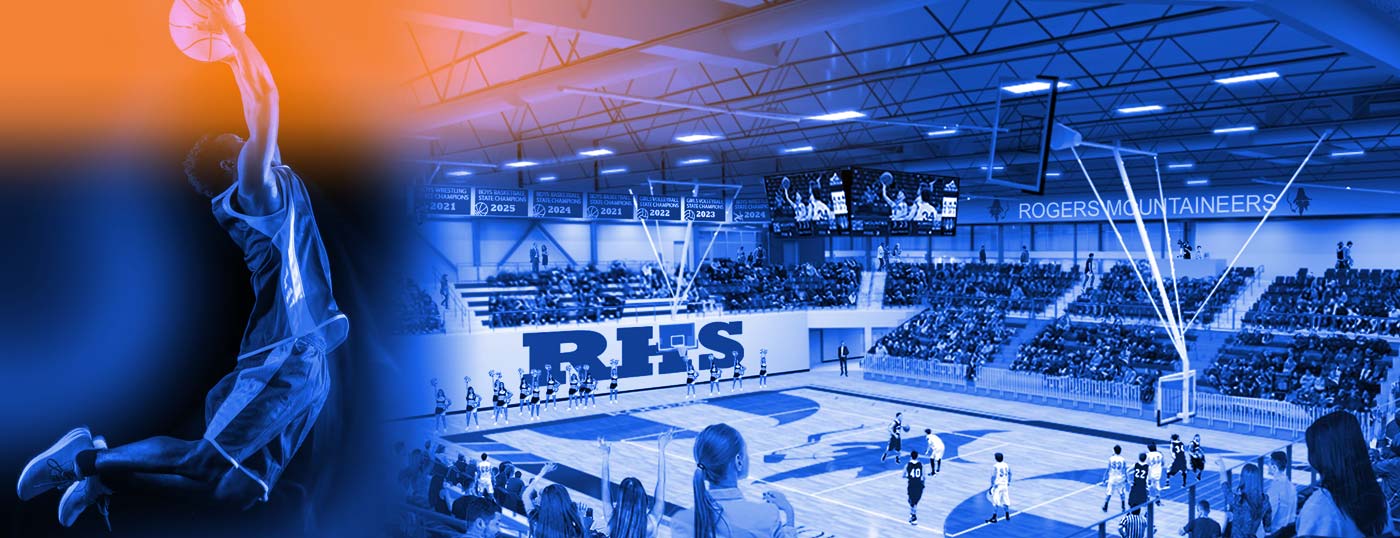
Hight Jackson Associates
Rogers High School is building a new $16.5 million gymnasium for its basketball, volleyball, wrestling and cheer teams that will boost the athletic program in this northwest Arkansas community. Making it happen is an invested team of various trades working together to clear a formidable series of design and operational hurdles.
The competition gym, part of an overall $43 million Rogers School District improvement project, will seat 2,300 in an arena-like facility. Creating that kind of atmosphere necessitated intense thinking on the part of architectural firm Hight Jackson Associates and a flawless game plan by Flintco, LLC for building it. The facility also includes spaces for the future home of the wrestling and cheerleading squads.
A big part—literally—of the project is what’s being called Mountie Arena. It features 185-foot-long, 12-foot-deep double-pitched steel joists supporting acoustical architectural roof deck that soars 46 feet off the floor. In addition to the challenge of scale, the project had two other primary demands. The design of the new arena needed to match the architectural style of the existing school, which is based on a circle with curved walls. It also had to control the acoustics associated with screaming fans and the sounds of intense competition.
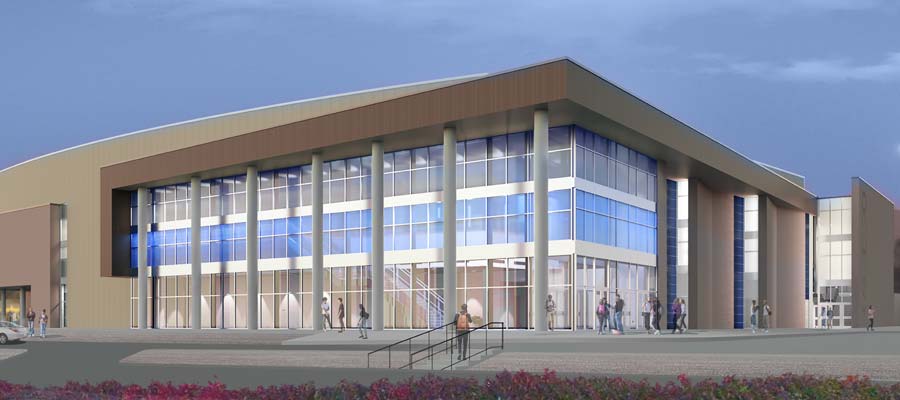
Hight Jackson Associates
The Rogers High School competition area features 14 super-long-span steel joists that are each 185 feet long and 12 feet deep at midspan. The joists are supporting white acoustic dovetail roof deck. The design was such that the south half of the joists could be erected in place and stabilized until the north half of the joists could be shipped to the site and mated to their corresponding half.
When he began sketching the design for the Rogers High School expansion using pen and paper in the summer of 2019, architect and Project Manager Jason Adams of Hight Jackson Associates roughly incorporated ideas gathered during meetings with the architectural design team, school district officials, athletic department representatives and coaching staffs. The idea, he says, is to allow the needs of the client to drive the design.
“Now it’s the architect’s job to figure out kind of a layout or a floor plan that tries to resolve as many of those issues as possible, if not all of those issues,” Adams says. “That’s part of the challenge. It’s also part of the fun as an architect to have all of these challenges and figure out how I can solve them all.”
In addressing the input gathered during the programming process, Adams and the Hight Jackson team eventually landed on a final design. That design, in turn, presented challenges of its own.
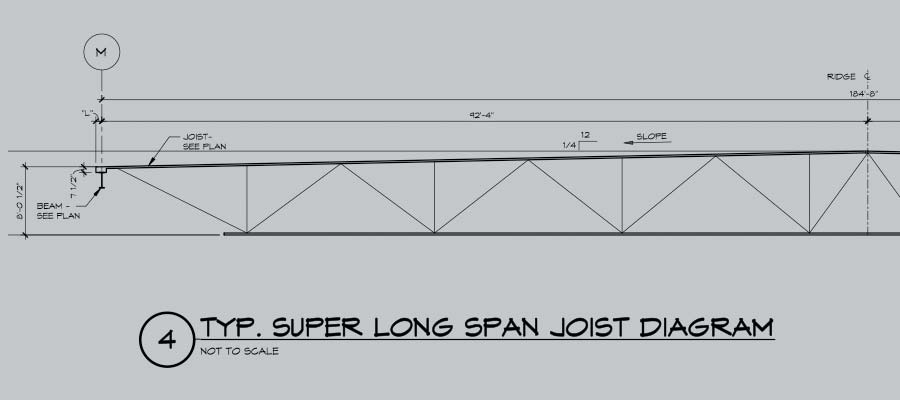
Hight Jackson Associates
To achieve the professional atmosphere of Mountie Arena, 14 of the 185-foot joists were used to create massive clear spans. Gerald Venable, manager of engineering and research at New Millennium Building Systems, says the joists’ length is “close to maximizing our capabilities.”
The joists support not only the roof deck, roof-top units and suspended basketball goals but also the enormous scoreboard being planned to hang over center court.
All those elements come together to make a tremendous first impression, says Bryan Casillas, structural engineer at Tatum-Smith-Welcher, noting the wide-open expanse and four sides of seating.
Adams has high expectations for the facility.
“We’re trying to give the students something they can be proud of—there are a lot of case studies that have found that buildings inspire people,” Adams says. “We try to inspire the community as well.”
Like a literal square peg in a round hole, the new Mountie Arena presented a design challenge from the jump. Adams explains.
“There are a lot of curves in the existing building,” he says. “So we knew we couldn’t just take a basketball arena, which is basically a rectangle, and stick it on the end of a circle. It would look completely out of place with no design context.”
To create architectural continuity, the Hight Jackson Associates team envisioned a sweeping curved wall on the west side of Mountie Arena.
That decision impacted a series of other design and erection considerations. A curved wall would have necessitated joists of different lengths and roof deck panels individually cut to fit. Realizing this issue, the orientation of the 185-foot joists was reconsidered to eliminate the need for differing lengths. Roof deck installation was adjusted in the field to match the curve. The solutions required teamwork between the architect, the structural engineer, New Millennium Building Systems and the erector.
Cheering. Squeaking sneakers. Bouncing balls. A booming sound system. Anyone who’s ever been to a high school gymnasium during a basketball game can tell you how loud it can be. “You don’t want it to sound like you have your head up to a tin can,” Casillas says with a laugh.
That also was a guiding concern for Adams and Hight Jackson Associates’ acoustical engineers. They selected acoustical dovetail roof deck to control the ambient noise in the main gym without using additional sound-mitigating material. Adams says the final result passed the test.
“We had an acoustician doublecheck sound levels and spaces,” he says. “We asked, ‘What about the competition gym? Do we need to address any of the acoustics in the gym or is the current acoustical deck meeting the need?’ They ran the numbers and said, ‘Yeah, you’re good.’”
Solving the three main design challenges of the new Rogers High School gymnasium required a project team performing at the top of its game. Nowhere was that more apparent than with the complex design and erection of the joists and acoustical dovetail roof deck.
Before they were even manufactured, the joists exposed a problem. With one side of Mountie Arena designed as a symmetrical arc, Adams says a realization set in.
“We had the joists intersecting the curve, so that meant only two joists would have been the same length—one on the north side and one on the south side,” he says. “Our structural engineer said, ‘You know, it would be more economical to run your joists along the long span instead of the short span. That way they’re all the same length. It will be much more economical to fabricate them even though they will be longer.’”
Because of their length, Venable says the 14 joists were built in two pieces then joined in the field via a bolted connection.
Mountie Arena’s expansive size—both in length and height—demanded special attention during joist erection. It was up to Hayden Witcofski, lead project manager and chief operations officer at Wilshar Steel Erectors, to pull it off. His task was made more difficult with the decision to change the orientation of the joists to run parallel with the length of the basketball/volleyball court. That changed the whole way the joists would be erected.
“It’s typical to build these long-span trusses on the ground and then bring in a large crane to set them in place from the outside of the building,” Witcofski says. The building’s layout and lack of space at the cramped job site eliminated this erection method. Instead, Witcofski came up with the idea to erect the joists in two pieces inside the building.
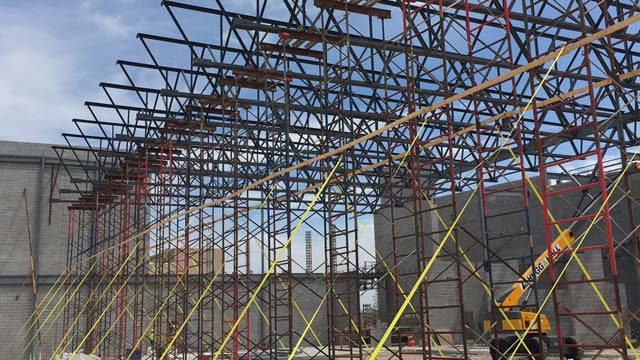
Wilshar Steel Erectors
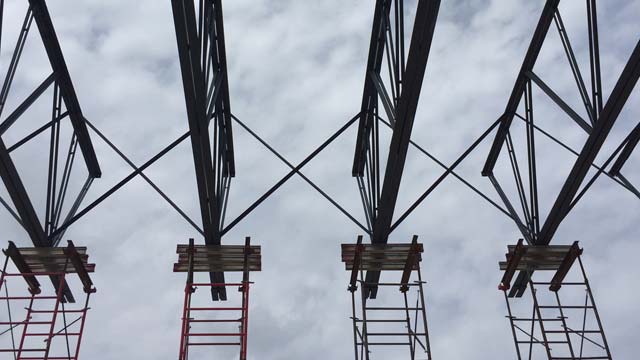
The first step in the joist installation is the erection of a row of shoring 34 feet high.
Although the plan would be carried out in the field, Venable and New Millennium had an important role to play even before the joists were manufactured.
“We had to do a preliminary design on the gym joists to determine the geometry so that we could give the erector the location of our panel points,” he says. “This enabled them to locate their shoring towers so that when the joists arrived they were ready to erect.”
In addition, Venable says the design of the joists had to reflect the shoring and erection plans.
“Part of our coordination was ensuring that we had all of the proper bridging locations and number of rows of bridging determined for the safe erection of the joist halves,” he explains. “Special consideration had to be given to the design of the joists as well since the south half of the joist was now considered an independent structure with the typical underslung bearing condition at the south wall and the bottom chord bearing condition at the shoring tower.”
The early design work and cooperation paid off, as joist erection went smoothly. Witcofski says the project realized several benefits using the plan he devised.
“No. 1, it was a simple process. It did not require a lot of geometry planning with the size of the joists,” he says. “No. 2, other trades were able to continue to work during erection because we weren’t shutting down a lot of job site for very long. And No. 3, we were able to use a smaller crane. We were able to use less equipment and less manpower for one single lift with the short pieces compared to the long pieces.”
With the project slightly behind schedule because of a particularly rainy winter, the time saved using this erection method was important. As the Wilshar Steel Erectors team installed the shoring, the rest of the project team continued working elsewhere on the facility.
“If we were to have built all of these on the ground as a full-span joist, it was going to take close to four weeks with a two-week duration to shut down the project to other trades,” Witcofski says. “We picked up almost two weeks of time doing it this way.”
“We only have so many man hours to build this building on budget. This just really simplified our setup process.”
“I guarantee we’ll do it this way again because it went so well. But it all has to do with circumstances of the building and the geometry, the layout and the real estate of the facility that we’re working around.”
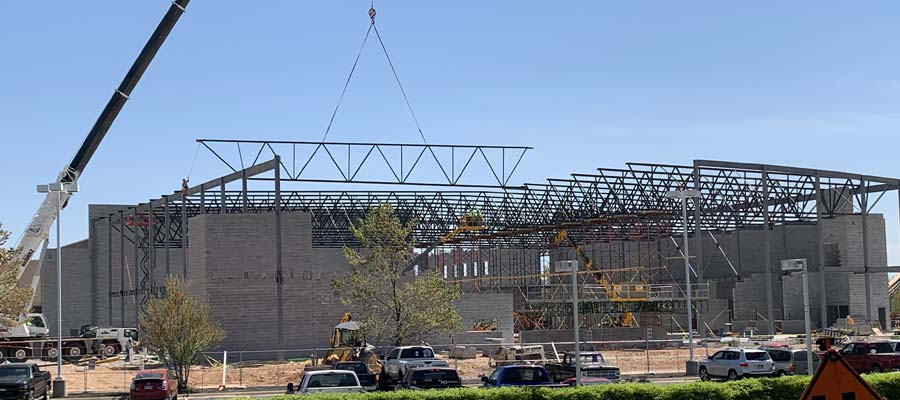
After shoring was erected, cranes first brought in one side of each of the 14 super-long-span joists. A few days later, the second side of the joists were delivered, set into place and bolted together.
Mountie Arena is made up of three main areas: The main competition gym, a concourse going around it behind the highest level of seating and ground-level areas leading into the gym. In the competition gym, Adams chose to use acoustic roof deck while the area above the concourse features standard dovetail roof deck with an acoustic drop ceiling. The “lobby” or entrance area at ground level features exposed dovetail roof deck.
In addition to mitigating the noise generated during intense basketball games or volleyball matches, the acoustic dovetail roof deck introduced costs savings, Adams says.
“It has become common knowledge that it’s actually more affordable to use acoustical deck than it is to do dropped ceiling sometimes,” he says. “By spending a little bit more money for the deck, you end up saving a lot more money because now you don’t need as much acoustical material inside the space.”
Venable says the acoustical deck, in this case Versa-Dek® LS 3.5 acoustical, achieves a noise reduction coefficient of .95. The deck is painted white, in keeping with the school’s blue-and-white color scheme.
The sweeping, west wall of Mountie Arena helped create a unifying look at Rogers High School but complicated installation of the dovetail roof deck. Each deck panel that came in contact with the curve had to be cut in the field to match, a time- and labor-intensive step.
“New Millennium has to ensure that they’re providing enough deck, so that it can be field-modified,” Casillas says. “The installers in the field have to figure out ways to modify that deck so that it can fit this curved profile of the west side of the building.”
Mountie Arena is made up of a combination of concrete masonry unit (CMU) walls and light-gage steel walls that are supported by a steel frame. Changing the joist orientation to run parallel with the court required special work connecting the roof deck to the CMU walls, as the joists do not come in direct contact with the CMU walls.
The challenge was especially significant along the west-side curved CMU wall, Adams says. The steel frame beams form a segmented arch on that side, he explains, leaving a gap between the beams and the CMU wall.
The solution involved a rolled steel angle that “hugs” the CMU wall connected to an 8-inch steel plate that extends from the top of the metal stud-framed wall.
“The structural engineer and I worked through some of these items on the phone and/or emails, and I suggested the solution of using flat plates cantilevered off of the steel beams to support the rolled steel angle,” Adams says. “Then the angle catches the steel decking and ties the roof decking diaphragm to the exterior wall and structure.”
“It was an out-of-the-box thinking solution.”
When it’s complete, the Rogers High School gymnasium will give the school a contemporary look that blends with the existing structure. Inside, athletes, students, staff and the community will be treated to an exciting atmosphere, with seating on all four sides as well as the corners of the court.
The Rogers High School Mounties play their first basketball game in the arena in November. The date represents the culmination of more than a year’s work involving a team of invested collaborators with one goal in mind: Give the community something to be proud of for years.
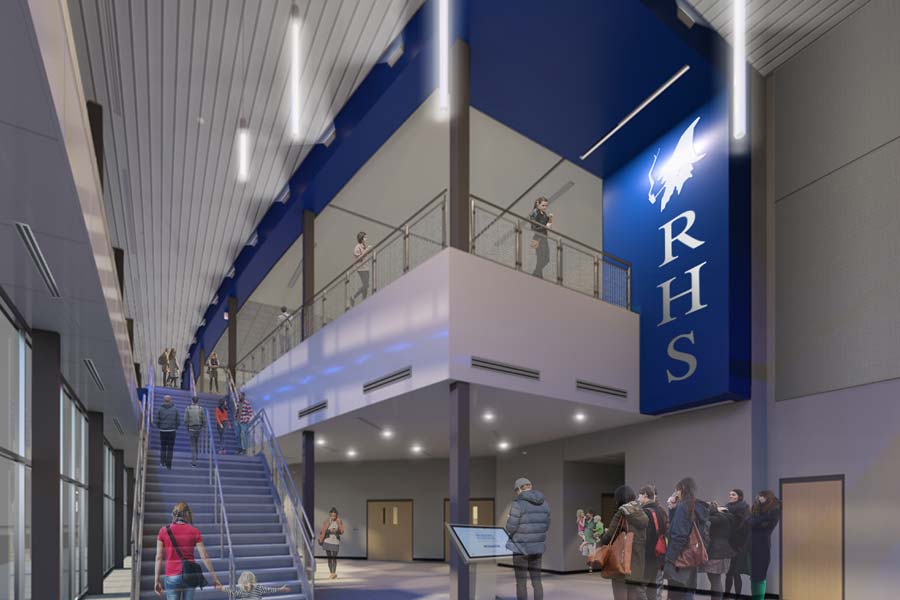
Hight Jackson Associates
Exposed dovetail roof deck is featured in Mountie Arena’s entry areas.
“We’re proud of it, and we’re excited for the community,” says Adams, who has a daughter in the Rogers school system. “We feel like it’s an investment. It gives us a lot of sense of pride. For the athletes and the student body, it gives them something to strive for. Architecture does evoke thoughts and emotions and feelings—a space will make you feel a certain way.”
Casillas agrees.
“We’re all really excited to see this project come together and be a source of entertainment and something the Rogers public schools can really be proud of for decades to come. It’s going to be a really nice addition to the Northwest Arkansas community.”
Building a better steel experience